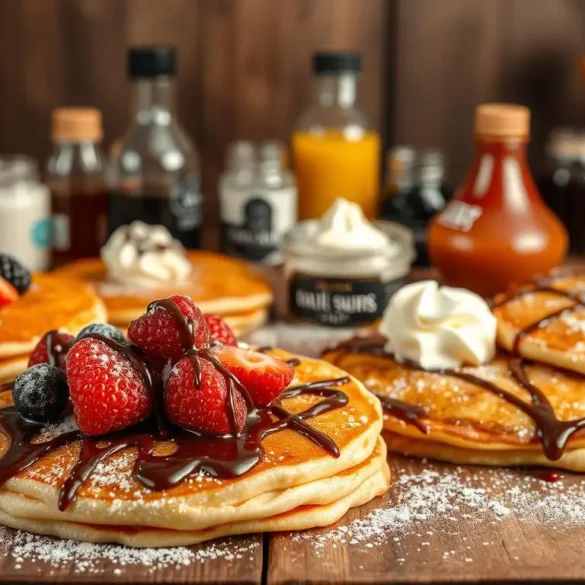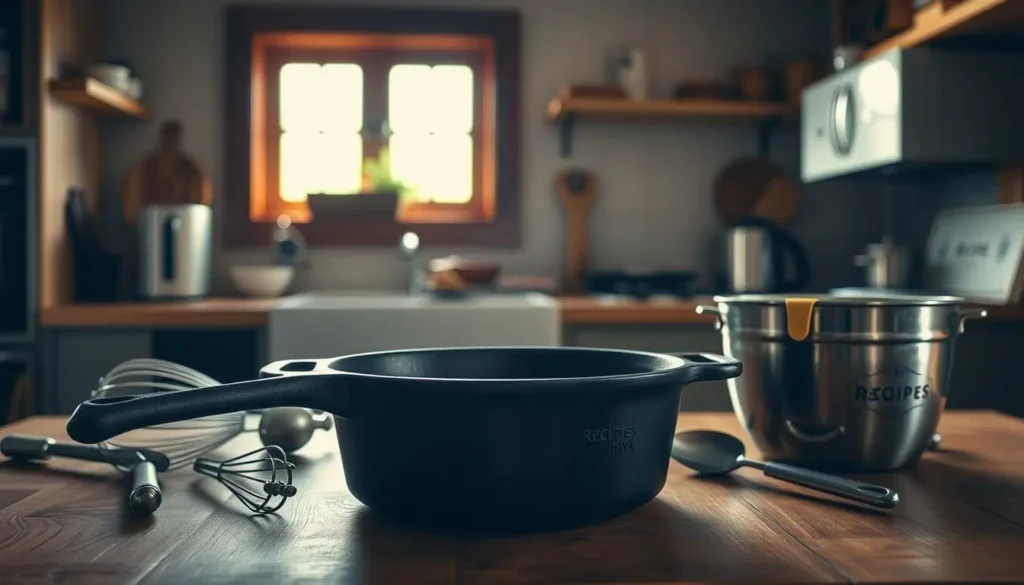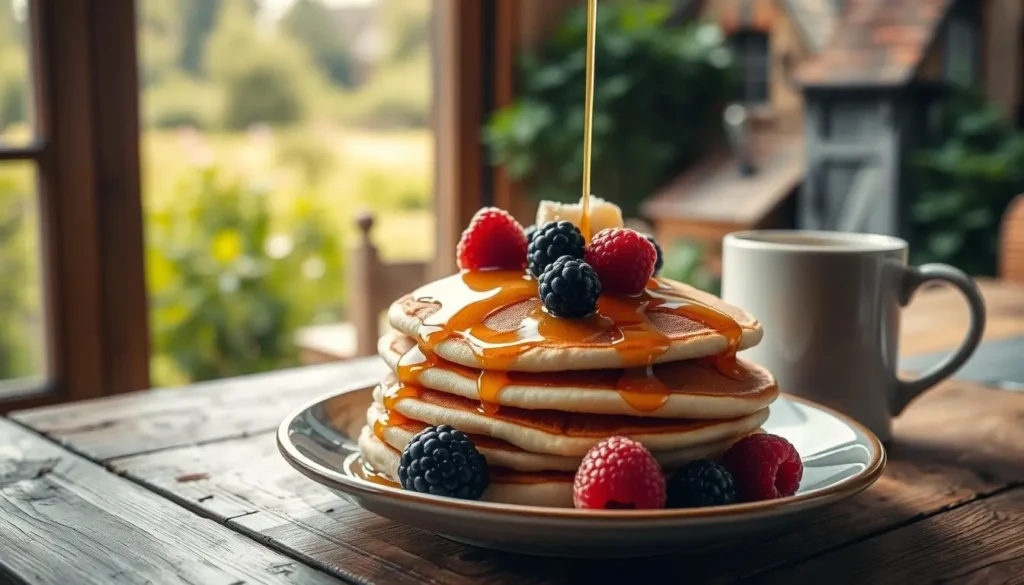
Ingredients
- 3 large eggs
- 1 cup all-purpose flour
- 1 cup milk
- 1/4 cup melted butter
- 1 tablespoon sugar
- 1/2 teaspoon vanilla extract
- 1/4 teaspoon salt
- Powdered sugar for dusting
- Fresh fruit (optional)
Instructions
Preheat the oven to 425°F (220°C). Grease a 9x13-inch baking dish with butter or cooking spray.
In a large bowl, whisk together eggs, milk, melted butter, sugar, vanilla extract, and salt until smooth.
Gradually add flour to the egg mixture, whisking until combined and no lumps remain.
Pour the pancake batter into the prepared baking dish and spread it out evenly.
Bake in the preheated oven for 20 minutes, or until the pancake is puffed and golden brown.
Remove from the oven and dust with powdered sugar. Serve with fresh fruit or syrup, if desired.
Notes
For an extra touch, top your German pancake with berries, whipped cream, or a drizzle of maple syrup. You can also experiment with adding cinnamon or nutmeg for a warm spice flavor.
Table of Contents
Ever wondered what makes breakfast truly magical? The German pancake recipe might just be your culinary discovery. This fluffy German pancake is more than a recipe. It’s an experience that turns mornings into special moments.
Thank you for reading this post, don't forget to subscribe!The German pancake rises dramatically in the oven, creating a puffy, golden masterpiece. It impresses everyone with its unique preparation. It combines simple ingredients with professional baking techniques.
Imagine serving a pancake that looks like it came from a fancy restaurant. Yet, it’s easy to make. This breakfast recipe makes your morning meal special with its impressive look and rich flavor.
Key Takeaways
- Easy to prepare with basic kitchen ingredients
- Dramatic oven-baked rising technique
- Versatile dish for sweet and savory preferences
- Impressive presentation for breakfast or brunch
- Quick cooking time under 30 minutes
What is a German Pancake?
A german pancake, also known as a dutch baby pancake, is a special breakfast dish. It’s unlike regular pancakes because it puffs up in the oven. This makes it a showstopper at any breakfast table.
This pancake is light and eggy, with golden edges and a soft center. It’s made in a cast-iron skillet or baking dish. This sets it apart from pancakes cooked on the stovetop.
Culinary Origins
The history of german pancakes is interesting. Even though it’s called a German pancake, it might have started in Germany but became famous in the U.S. by German immigrants. Some say “dutch baby” comes from “Deutsch” (German), not Dutch.
- Originated in German-American communities
- Became popular in early 20th-century America
- Adapted from traditional European pancake recipes
Distinctive Characteristics
This pancake is special because of how it’s made. It rises in the oven, turning into a bowl-like shape with crispy edges. Its texture is like a soufflé, crepe, and pancake all mixed together.
| Feature | Description |
|---|---|
| Texture | Light, puffy, custard-like |
| Cooking Method | Baked in oven, not on stovetop |
| Primary Ingredients | Eggs, flour, milk, butter |
Ingredients Needed for German Pancakes
To make the perfect German pancake, you need to pick the right ingredients. Your dutch baby pancake recipe works best with quality items in your kitchen.
The key to a tasty German pancake is a few basic ingredients. They turn into a fluffy, impressive breakfast dish.
Key Components
- Eggs: The main binder and leavening agent
- All-purpose flour: Builds the pancake’s structure
- Whole milk: Adds richness and a smooth texture
- Unsalted butter: Brings flavor and helps with browning
- Pinch of salt: Boosts the taste
Optional Add-Ins for German Pancake Variations
Trying different german pancake variations lets you make it your own. Here are some fun additions:
- Vanilla extract for sweetness
- Cinnamon for a warm spice
- Lemon zest for a bright flavor
- Fresh berries for natural sweetness
- Chopped nuts for crunch
The beauty of a dutch baby pancake recipe is its simplicity and flexibility. It’s great for both sweet and savory dishes. These ingredients let you get creative in the kitchen.
The Equipment You Will Need
To make tasty German pancakes, you need the right tools. Choosing the best german pancake pan and mixing tools is key. Knowing what you need helps you make perfect pancakes every time.

Both pros and home cooks say the right gear makes a big difference. The right dutch baby skillet and tools are crucial for that fluffy texture.
Baking Dish Options
When picking baking gear for German pancakes, consider these:
- Cast iron skillet (10-12 inches recommended)
- Ceramic baking dish
- Oven-safe stainless steel pan
- Specialized dutch baby skillet
Pro tip: Cast iron skillets are best for that crispy edge and even heat.
Mixing Tools
Here’s what you need for mixing:
- Large mixing bowl
- Whisk or electric mixer
- Measuring cups and spoons
- Spatula for batter prep
“The right tools transform good cooking into great cooking.” – Professional Chef
| Equipment Type | Recommended Material | Best Use |
|---|---|---|
| Skillet | Cast Iron | Even heat distribution |
| Mixing Bowl | Stainless Steel | Easy batter mixing |
| Whisk | Stainless Steel | Smooth batter consistency |
Quality baking equipment for German pancakes means tasty results every time.
Step-by-Step Instructions
Learning to make German pancakes is a fun journey. It turns simple ingredients into a tasty breakfast treat. This guide will help you bake German pancakes with ease and confidence.
Mastering German pancake cooking takes focus and a few key steps. It might seem hard at first, but with practice, you’ll make beautiful puffy pancakes. They’ll wow your family and friends.
Preparing the Batter
Getting the batter right is key for that light and airy texture. Here’s what to do:
- Gather all ingredients at room temperature
- Whisk eggs until they become light and frothy
- Gradually add flour and milk
- Mix until smooth with no lumps
- Let the batter rest for 10-15 minutes
Baking the Pancakes
The right baking technique is essential. Preheat your oven to 425°F and follow these steps:
- Place a cast-iron skillet or baking dish in the oven while preheating
- Add butter to create a non-stick surface
- Pour batter into the hot pan
- Bake for 15-20 minutes until edges are golden and puffy
Cooling and Serving
The last steps are cooling and serving. Let the pancake rest for a few minutes after baking. The puff will deflate, creating beautiful folds. Dust with powdered sugar, add fresh berries, or drizzle with maple syrup for a delicious breakfast.
Tips for the Perfect German Pancake
Mastering German pancakes takes some special techniques and tips. Whether you’re new to cooking or have lots of experience, these tips will make your breakfast dish a hit.
Making perfect dutch baby pancakes is easier than you think. It’s all about the small details that make a big difference.
Smart Ingredient Substitutions
Being flexible with ingredients can solve many problems. Here are some substitutions to try:
- Gluten-free flour for traditional wheat flour
- Almond milk instead of regular milk
- Coconut oil as a butter replacement
- Egg alternatives like flax eggs for vegan versions
Avoiding Common Pancake Pitfalls
To avoid flat or soggy pancakes, follow these tips:
- Make sure ingredients are at room temperature
- Whisk the batter until it’s smooth but not overmixed
- Preheat your baking dish for crispy edges
- Use a cast-iron skillet for even heat
Pro tip: The secret to a puffy German pancake is high heat and the right mix of ingredients. Your batter should be thin but strong. This will give you those amazing rises and golden edges.
Flavor Variations
German pancakes, also known as dutch baby pancakes, are a blank canvas for creativity. They can be sweet or savory, making breakfast exciting with just a few ingredients.

Exploring german pancake flavors lets you tailor your meal to your liking. These puffy pancakes are incredibly adaptable.
Sweet Dutch Baby Recipes
For sweet dutch baby recipes, you have many tasty choices:
- Classic powdered sugar with fresh lemon juice
- Mixed berry compote
- Caramelized banana slices
- Nutella and whipped cream
- Maple syrup with toasted nuts
Savory German Pancake Ideas
For savory german pancake ideas, try these delicious options:
- Herb-infused with fresh chives
- Crispy bacon and cheddar cheese
- Spinach and feta cheese
- Smoked salmon with dill
- Roasted vegetable medley
“The secret to an amazing German pancake is experimenting with flavors!” – Professional Chef
| Flavor Category | Top Recommendation | Preparation Time |
|---|---|---|
| Sweet | Mixed Berry Compote | 15 minutes |
| Savory | Bacon and Cheddar | 20 minutes |
| Gourmet | Smoked Salmon with Dill | 25 minutes |
Pro tip: Always serve your German pancake immediately after baking to maintain its signature puffy texture and maximum flavor impact.
Serving Suggestions
Learning how to serve German pancakes can turn a simple breakfast into a special treat. These fluffy Dutch baby pancakes are great with many different toppings and ways to present them.
Ideal Accompaniments
There are many tasty options for dutch baby accompaniments to make your breakfast unforgettable:
- Fresh seasonal berries
- Crispy bacon strips
- Maple-glazed breakfast sausages
- Whipped cream
- Powdered sugar dusting
- Fruit compotes
Beverage Pairings
Choosing the right drink can make your German pancake breakfast even better. Here are some great drink options:
- Classic Coffee: A strong coffee goes well with the pancake’s softness
- Fresh-squeezed orange juice
- Chai latte
- Herbal tea
- Sparkling mimosa (for weekend brunches)
Try different combinations to find your favorite German pancake breakfast. The goal is to mix flavors and make a plate that looks and tastes great.
Storage and Reheating
Enjoying your German pancakes doesn’t stop after the first bite. Learning how to store and reheat them can make them last longer. It also helps reduce food waste.
Proper Storage Techniques
Storing German pancakes right is key to keeping them tasty. Here’s how to store them:
- Let pancakes cool down completely before storing
- Wrap each pancake in plastic wrap or aluminum foil
- Put the wrapped pancakes in an airtight container
- Keep them in the fridge for 2-3 days
Reheating Dutch Baby Pancakes
To reheat Dutch baby pancakes, aim for their crispy edges and fluffy center. Here’s how:
- Oven Method:
- Heat your oven to 350°F
- Put pancakes on a baking sheet
- Warm them for 5-7 minutes
- Skillet Method:
- Heat a non-stick skillet over medium heat
- Warm pancakes for 1-2 minutes on each side
- Add a bit of butter for extra taste
Creative Leftover Ideas
Turn leftover German pancakes into new dishes. Here are some ideas:
- Roll them up with sweet fillings
- Cut into strips for a crispy salad topping
- Use as a base for savory breakfast wraps
- Make pancake French toast by dipping in egg
With these tips, you can enjoy your German pancakes again and again. They’ll stay delicious.
Nutritional Information
Understanding german pancake nutrition is key for health-focused food lovers. These treats are not just tasty but also offer a surprising nutritional profile. They can fit into many dietary plans.

A typical german pancake, or dutch baby, has about 250-300 calories per serving. The nutritional breakdown shows a mix of macronutrients. This mix can be adjusted for healthier eating.
Caloric Breakdown
Here’s a look at the typical nutritional components of a standard german pancake:
- Calories: 275-300
- Protein: 8-10 grams
- Carbohydrates: 25-30 grams
- Fat: 15-18 grams
Healthy Dutch Baby Recipe Alternatives
For those looking for low-calorie german pancakes, smart substitutions can make this dish nutritious:
- Use whole wheat flour to boost fiber
- Replace whole milk with almond or skim milk
- Add egg whites to lower cholesterol
- Top with fresh berries instead of powdered sugar
By making smart ingredient swaps, you can enjoy a tasty german pancake while keeping your diet balanced. The trick is to eat in moderation and make smart nutritional choices.
Popular German Pancake Recipes
German pancake recipes come in many flavors for all tastes and diets. Whether you want a traditional breakfast or something new, these recipes will spark your creativity.
Recipes for Special Diets
Even with dietary limits, you can still enjoy tasty pancakes. Here are some great options:
- Gluten-free dutch baby: Use almond or rice flour instead of wheat for those with gluten intolerance
- Vegan german pancakes: Choose plant-based milk and egg replacers like flaxseed or aquafaba
- Keto-friendly version: Try coconut or cauliflower flour instead of regular flour
Seasonal Variations
Make your German pancakes special with seasonal ingredients. They add unique tastes to your breakfast:
| Season | Ingredient Suggestion | Flavor Profile |
|---|---|---|
| Spring | Fresh strawberries | Light and fruity |
| Summer | Blueberries and lavender | Refreshing and aromatic |
| Autumn | Pumpkin puree and cinnamon | Warm and comforting |
| Winter | Spiced apple compote | Rich and hearty |
Try these german pancake recipe variations to find new favorites. From gluten-free to vegan, there’s something for everyone to love.
Frequently Asked Questions
German pancake FAQs are key for home cooks aiming to perfect this tasty breakfast dish. Whether you’re new to baking or have experience, knowing how to fix Dutch baby issues can lead to success every time.
German pancakes can be tricky to master. We’ve gathered the most common questions to help you get crispy pancakes and solve cooking problems.
Exploring Pan Options for Your German Pancake
Finding the right pan is vital for a perfect German pancake. While a cast-iron skillet is best, you have other options:
- Ceramic baking dishes are great for even heat
- Heavy-bottom metal pans can also work well
- Avoid thin or lightweight pans for even cooking
Achieving the Crispiest German Pancake
For crispy german pancakes, follow these tips to elevate your breakfast:
- Preheat your pan with butter until it’s hot
- Use room temperature eggs for better batter
- Make sure your oven is preheated before adding batter
- Don’t overmix the batter to keep it light
Pro tip: The secret to a crispy exterior is high heat and minimal handling.
Dutch baby troubleshooting is simple with these tips. You’ll soon be making restaurant-quality German pancakes at home.
Reader Reviews and Experiences
Our German pancake recipe has brought joy to many home cooks in the United States. People are sharing their own dutch baby recipe feedback. They show how they’ve made this dish their own with unique twists.
Sarah from Seattle loves making these pancakes for her family every weekend. She adds fresh berries and powdered sugar, inspiring others to try new things. This shows how versatile and loved this classic breakfast dish is.
What Our Readers Are Saying
Cooking fans have shared many success stories and photos. Both professional chefs and weekend bakers love this recipe. They say mastering it is very rewarding.
The recipe is easy to follow and can be changed in many ways. This makes it a hit with both new and seasoned cooks.
Share Your Own Recipe!
We want you to join our cooking community! Do you have a special German pancake recipe? We’re eager to hear about it. Share your recipe, tips, and experiences to inspire others and grow our cooking knowledge together.
FAQ
What makes an authentic Italian bread different from other bread types?
Authentic Italian bread is known for its crispy crust and soft inside. It’s made with simple ingredients like flour, water, yeast, and salt. Unlike other breads, it doesn’t have eggs or sugar.
The bread is chewy and has a light crumb. It’s great for dipping in olive oil or with meals.
How long does it take to make homemade Italian bread?
Making homemade Italian bread takes 3 to 4 hours. This includes prep, rising, and baking. You’ll spend about 30-45 minutes actually working on it.
The rest of the time is for the dough to rise and get flavorful. Baking takes 25-30 minutes in a hot oven.
Can I make Italian bread without a stand mixer?
Yes, you can make Italian bread by hand. Traditional bakers have done it for centuries without mixers. Kneading the dough manually takes 10-15 minutes.
This develops the gluten for the right texture.
What are the best flour types for Italian bread?
Use bread flour or 00 flour for authentic Italian bread. Bread flour’s high protein content makes it chewy. If you can’t find 00 flour, mix bread flour with all-purpose flour.
Some bakers mix flours for a richer flavor.
How do I get a crispy crust on my homemade Italian bread?
For a crispy crust, use a few tricks. Create steam in the oven with a pan of hot water or spray water in. Preheat your baking stone or sheet for a crisp bottom.
A hot oven (425-450°F) is key for a golden crust.
How long will homemade Italian bread stay fresh?
Enjoy homemade Italian bread within 1-2 days. Store it in a paper bag at room temperature. Avoid plastic bags to keep the crust crisp.
To freeze, wrap the bread tightly. Thaw at room temperature and warm briefly in the oven for a crispy crust.
Are there gluten-free options for Italian bread?
Yes, you can make gluten-free Italian bread. Use almond flour, rice flour, or gluten-free blends. The texture will differ from wheat bread.
Adding xanthan gum can improve the bread’s structure with gluten-free flours.
What are some common mistakes to avoid when making Italian bread?
Avoid using too hot water, which can kill the yeast. Don’t knead too little or let it rise too short. Too much flour makes the bread dense.
Use fresh yeast and let the dough rise in a warm, draft-free place. Be patient for the best results.


